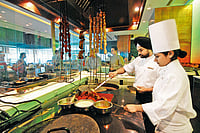The wrecking ball appears to have grown a morbid hatred towards Patna’s heritage buildings—like the Collectorate, which was saved by the bell for the time being, and now the Patna Medical College and Hospital (PMCH), founded in 1925 as the Prince of Wales Medical College. Or, as some would say, the demolition mirrors our love to create something new and afresh. Whichever side one takes, a piece of history will be demolished. CM Nitish Kumar laid the foundation of a redevelopment project at the PMCH, where the old structures will make room for a 5,462-bed hospital complex to be built over seven years with an outlay of Rs 5,540 crore.
It’s a grand plan to rejuvenate Bihar’s creaky healthcare system, but has not gone down well with many people, including the PMCH alumni. A suggestion was to preserve the buildings as they were in 1921, and develop annexes in and around Patna on the lines of AIIMS extension centres. “We have personal memories with this college,” UK-based doctor Abu Eesa Siddiqui told PTI. “My father and youngest brother graduated from Patna Medical College. Hopefully, the PMCH alumni can create awareness on this issue and appeal to the government to spare iconic landmarks on its campus.”
Bihar and Orissa’s first medical college was named after the Prince of Wales, later King Edward VIII, when he visited Patna, then a young provincial capital, in December 1921. It was during this tour that the Prince of Wales inaugurated the Victoria Memorial in Calcutta. The medical college by the Ganga was renamed after Independence and its complex has several historical buildings, including the Bankipore General Hospital and Women Hospital, outfitted with special elevators.
Before the PMCH demolition plan, the fate of the Patna Collectorate was in the balance as authorities pressed for a raze-and-rebuild project in the 12-acre complex, parts of which are over 250 years old. It has high ceilings, huge doors and hanging skylights, and also featured in the Oscar-winning film Gandhi. The Supreme Court stopped the drive to demolish a testimony to the city’s rich commercial past from the Dutch and British eras.
Experts have urged locals to cultivate a sense of ownership for heritage, including Hardinge Park, the famed garden built in honour of Viceroy Lord Hardinge, who was instrumental in creating Bihar and Orissa as separate provinces. Built as Patna’s first public park, it was opened on January 31, 1916. It had a five-tonne life-size bronze statue of the viceroy in full Durbar regalia. On its 105th anniversary this year, the park set over 22 acres had hardly any heritage to showcase, except for two Ramgarh Raj Pavilions that survived the country’s freedom and post-colonial vandalism. Like everything else, it lost its name too—since renamed as Shaheed Veer Kunwar Singh Azadi Park.


























